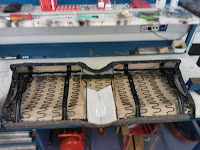There were minor jobs to do in order to finish my top replacement project. The header bow was spread some glue on and header seal was stapled on. The seal has two layers so I hit the staples between them and added glue to mate the layers.
| Glue, staples and some more glue. |
| Header bow seal in place. It should have been a bit more ahead to make it easier to latch the top closed. |
Then the new flat metal listing was slipped in the listing pockets and screwed in to bow #2 and #3. These did fine. Hint: the distance between the pockets can be used as guide when defining the distance between bows when they are stapled to the stay pads. I didn't measure but succeeded by chance.
In my opinion and based on my trial&error, hitting staples to bow #4 are not needed until now, in the very final stage of project.
Followed by wire-on.
I had purchased a set of new weatherstripping for the top. Sadly no pictures available. The hint for the installation is to first install all weatherstripping loosely , then verifying the fit prior to screwing and gluing. The long weatherstrip for header was not perfect fit and needed some modification.
The Epilogue
Below are a couple of shots of what came out of the project. Once I finished with the top replacement the springtime was at hand and I folded the top down where it remained until the end of September when it was too cold to drive with open top.
| A new car smell |
| The interior quarter trims got new skins |
 |
| Not sure what is the purpose of that piece hanging there in the rear |
 |
| The C-pillar area needs one more re-positioning |
 |
There are sort of "ears" where the edge turns from vertical to horizontal. The flaps should have been pulled even tighter. I just can't figure how. |
 |
| The dents have not straightened after months in the garage. |
The end result may not be the best possible but it keeps the rain out and no leaks have been found so far. The rear tacking strip is still waiting for my inspiration for doing it one more time.
Here are a couple hints if you are planning on replacing your top.
- I can not recommend EZOn vinyl top for anyone (especially not for '64-'66)
- EZOn is affordable, but not very flexible
- Every time the top is lowered and raised there are dents and lumps somewhere
- More valuable canvas material tops will look better on
- Consider hiring a pro to do the job for you
- The materials cost me altogether around € 600
- The estimated cost for a pro was from € 1500 to € 2000 including the materials
- If you are a stubborn DIY man (like I am)
- Have patience ! (which I didn't)
- The more time you spent, the better the result !






























